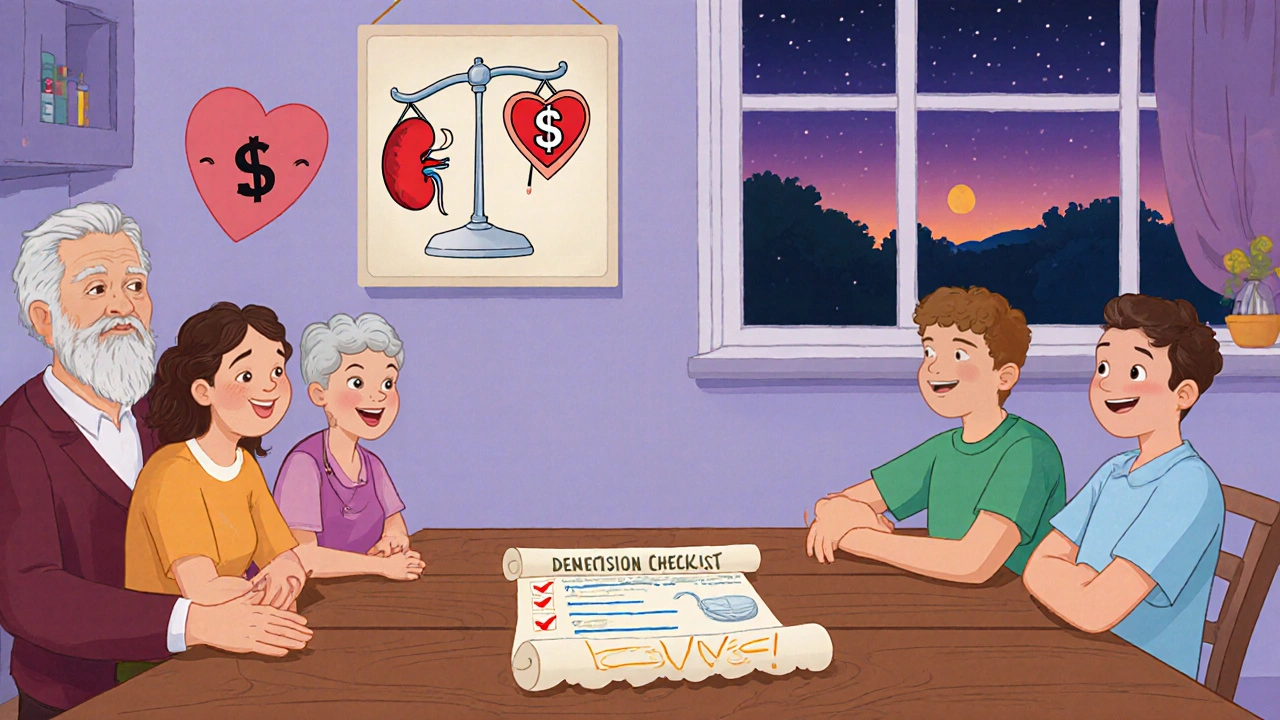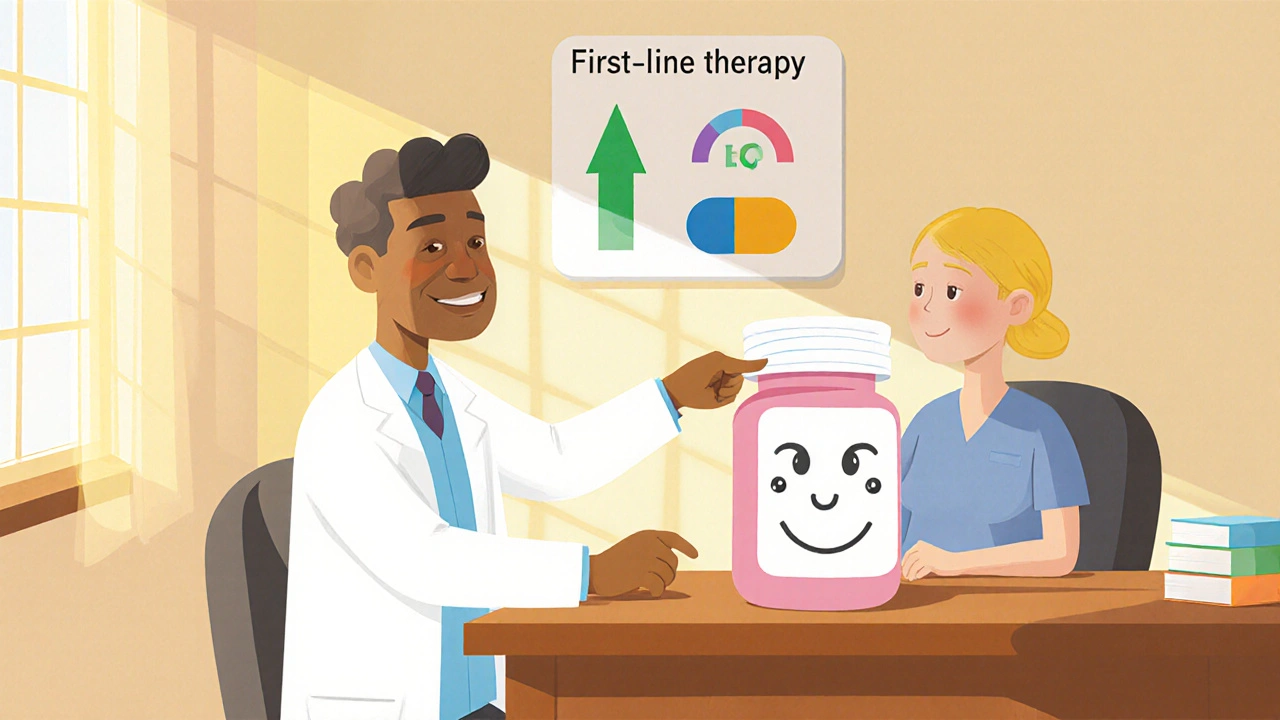Diabetes Medication A1c Reduction Calculator
Current A1c Level
Your Estimated Results
Expected A1c Reduction:
Your estimated A1c after treatment:
Comparison
| Medication Class | A1c Reduction | Weight Effect | Key Benefits | Common Side Effects |
|---|---|---|---|---|
| Metformin | 1.0-1.5% | Mild weight loss | Cost-effective, first-line | GI issues, rare lactic acidosis |
| GLP-1 Agonists | 0.8-1.3% | 3-5 kg weight loss | Heart & kidney protection | Nausea, vomiting |
| SGLT2 Inhibitors | 0.5-1.0% | 2-3 kg weight loss | Heart failure reduction | Urinary infections |
| Sulfonylureas | 1.0-1.5% | Weight gain | Fast-acting | Hypoglycemia |
| DPP-4 Inhibitors | 0.5-0.8% | Weight neutral | Low hypoglycemia risk | Mild side effects |
When it comes to controlling blood sugar in Type 2 Diabetes is a chronic condition affecting over 460 million adults worldwide, Metformin is usually the first drug doctors prescribe. But with a growing toolbox of newer agents, many patients wonder whether they should stick with Metformin or consider an alternative. This guide walks you through the most common options, breaking down how they work, how they stack up on key outcomes, and what practical factors might sway your choice.
Key Takeaways
- Metformin remains the most cost‑effective first‑line therapy, especially for patients without cardiovascular disease.
- GLP‑1 receptor agonists and SGLT2 inhibitors provide extra heart‑ and kidney‑protective benefits but cost more.
- Sulfonylureas drop A1c quickly but can cause hypoglycemia and weight gain.
- DPP‑4 inhibitors are weight‑neutral with low hypoglycemia risk but offer modest A1c reduction.
- Lifestyle modification (diet, exercise, weight loss) is essential with any medication and can sometimes replace drugs altogether.
How Each Class Lowers Blood Sugar
Understanding the mechanism helps you anticipate side effects and know which drug fits your health profile.
Metformin is a biguanide that reduces hepatic glucose production and improves peripheral insulin sensitivity. It works primarily in the liver, making it safe for most patients and unlikely to cause low blood sugar.
GLP‑1 receptor agonist mimics the incretin hormone GLP‑1, boosting insulin release after meals, slowing gastric emptying, and promoting satiety. Examples include liraglutide and semaglutide.
SGLT2 inhibitor blocks the sodium‑glucose co‑transporter 2 in the kidney, causing excess glucose to be excreted in urine. Common drugs are empagliflozin and dapagliflozin.
Sulfonylurea stimulates pancreatic beta cells to release more insulin regardless of blood glucose levels. Glipizide and glyburide are typical choices.
DPP‑4 inhibitor prevents breakdown of endogenous incretins, modestly enhancing insulin secretion and suppressing glucagon. Sitagliptin is a widely used example.
Lifestyle modification includes calorie‑controlled diet, regular aerobic activity, and weight loss, which directly improve insulin sensitivity. It’s the backbone of any pharmacologic regimen.
Efficacy: How Much Does A1c Drop?
Most studies report the average reduction in HbA1c a lab measure reflecting average blood glucose over the past 2‑3 months. Here’s a quick snapshot:
- Metformin: 1.0‑1.5% A1c reduction.
- GLP‑1 agonist: 0.8‑1.3% (often with weight loss of 3‑5kg).
- SGLT2 inhibitor: 0.5‑1.0% (plus 2‑3kg weight loss).
- Sulfonylurea: 1.0‑1.5% (fastest onset, but weight gain of ~2kg).
- DPP‑4 inhibitor: 0.5‑0.8% (neutral weight effect).
- Intensive lifestyle change: up to 1.0% when combined with 5‑10% body‑weight loss.
When you stack Metformin with a second agent, the combined A1c drop often reaches 1.5‑2.0%.
Side‑Effect Profile: What to Expect
Every drug brings pros and cons. Below is a quick risk rundown.
- Metformin: gastrointestinal upset (nausea, diarrhea) in ~25% of users; rare lactic acidosis.
- GLP‑1 agonist: nausea, vomiting, possible pancreatitis; injection site reactions.
- SGLT2 inhibitor: genital mycotic infections, increased urination, rare ketoacidosis.
- Sulfonylurea: hypoglycemia (especially in elderly), weight gain.
- DPP‑4 inhibitor: generally well‑tolerated; occasional nasopharyngitis.
- Lifestyle modification: muscle soreness initially, need for sustained motivation.

Cardiovascular & Renal Benefits
Beyond sugar control, some drugs protect the heart and kidneys-a growing priority for clinicians.
- GLP‑1 agonists (e.g., semaglutide) have shown a 15‑20% reduction in major adverse cardiovascular events (MACE).
- SGLT2 inhibitors (e.g., empagliflozin) cut heart‑failure hospitalizations by ~30% and slow diabetic kidney disease progression.
- Metformin modestly reduces cardiovascular risk in overweight patients, but the evidence isn’t as strong as the newer agents.
- Sulfonylureas and DPP‑4 inhibitors have neutral CV outcomes in large trials.
Cost & Accessibility
Affordability often decides what ends up on the pharmacy shelf.
- Metformin: generic, typically <$4‑$10 per month in the US.
- GLP‑1 agonist: $800‑$1000 per month (insurance may cover partially).
- SGLT2 inhibitor: $400‑$600 per month.
- Sulfonylurea: $10‑$30 per month (generic).
- DPP‑4 inhibitor: $200‑$350 per month.
- Lifestyle programs: cost varies; many free resources exist through community health centers.
Practical Decision‑Making Guide
Use the checklist below to match your situation with the right therapy.
- If you’re drug‑naïve, have mild‑to‑moderate hyperglycemia, and need a low‑cost starter → Metformin.
- If you have established cardiovascular disease or high heart‑failure risk → consider a GLP‑1 agonist or SGLT2 inhibitor.
- If you’re prone to hypoglycemia (elderly, renal impairment) → avoid sulfonylureas, favor DPP‑4 inhibitors or SGLT2 inhibitors.
- If weight loss is a priority → GLP‑1 agonist or SGLT2 inhibitor.
- If you’re on a strict budget and can tolerate occasional low blood sugar → sulfonylurea may be acceptable.
- Regardless of the drug, pair it with a structured lifestyle change for optimal results.

Comparison Table
| Drug Class | Typical Example | HbA1c Reduction | Weight Effect | Cardio‑Renal Benefit | Common Side Effects | Monthly Cost (US$) |
|---|---|---|---|---|---|---|
| Biguanide | Metformin | 1.0‑1.5% | Weight neutral or slight loss | Modest CV risk reduction | GI upset, rare lactic acidosis | 4‑10 |
| GLP‑1 Receptor Agonist | Semaglutide | 0.8‑1.3% | Loss of 3‑5kg | ↓ MACE 15‑20% | Nausea, vomiting, injection site | 800‑1000 |
| SGLT2 Inhibitor | Empagliflozin | 0.5‑1.0% | Loss of 2‑3kg | ↓ HF hospitalizations 30% | UTI, genital yeast infection | 400‑600 |
| Sulfonylurea | Glipizide | 1.0‑1.5% | Weight gain ~2kg | Neutral | Hypoglycemia, weight gain | 10‑30 |
| DPP‑4 Inhibitor | Sitagliptin | 0.5‑0.8% | Weight neutral | Neutral | Nasopharyngitis, mild GI | 200‑350 |
| Lifestyle Modification | Diet + Exercise | Up to 1.0% with 5‑10% weight loss | Variable (typically loss) | Improves all CV risk factors | Requires adherence, possible injury | Free‑low |
Frequently Asked Questions
Can I stop Metformin if I start a GLP‑1 agonist?
Often doctors will keep Metformin as a background therapy because it adds modest A1c reduction with little risk of hypoglycemia. Combining the two can achieve a bigger overall drop while allowing a lower dose of the GLP‑1 agent, which may reduce side‑effects.
Are SGLT2 inhibitors safe for people with kidney disease?
They are actually protective for chronic kidney disease, but they require a minimum eGFR (usually >30mL/min/1.73m²). Below that threshold, the drug isn’t effective and isn’t recommended.
Why do sulfonylureas cause weight gain?
Because they increase insulin levels regardless of glucose, the body stores more glucose as fat, leading to modest weight gain over time.
Do I need to monitor blood sugar more often on a GLP‑1 agonist?
GLP‑1 drugs rarely cause hypoglycemia on their own, so daily checks are optional unless you’re on another insulin‑secretagogue. Still, weekly logs help your clinician fine‑tune dosing.
Is lifestyle change alone enough for most patients?
If you achieve a 5‑10% body‑weight loss and sustain regular activity, many can keep A1c under 7% without medication, especially early in the disease. However, most need at least one drug as the disease progresses.
Next Steps & Troubleshooting
1. Talk to your provider about your cardiovascular and kidney health-these drive the choice between GLP‑1 and SGLT2 agents. 2. Review insurance coverage; a higher‑tier drug may be viable if the plan offers a specialty pharmacy benefit. 3. If you start a new drug and experience side effects, give it 2‑4 weeks to settle before switching-most GI or flu‑like symptoms improve. 4. Pair any medication with a realistic diet plan (e.g., Mediterranean‑style meals) and at least 150minutes of moderate activity per week. 5. Schedule quarterly labs (HbA1c, kidney function, liver enzymes) to track progress and catch adverse events early.
By matching your health goals, risk profile, and budget with the right therapy, you can keep blood sugar in check without sacrificing quality of life.

carol messum
October 15, 2025 AT 15:47Sometimes the simplest path, like metformin, feels like the most thoughtful choice.
Jennifer Ramos
October 16, 2025 AT 14:00Metformin's track record is solid, and for many folks it's a safe first step 😊. It keeps the liver from over‑producing glucose and doesn't usually cause hypoglycemia. If you add a GLP‑1 or SGLT2 later, you get extra heart‑kidney perks, but the price tag jumps. So start simple, watch your numbers, and only layer on if you need the extra boost 🙌.
abhi sharma
October 17, 2025 AT 12:13Oh great, another pill to add to the ever‑growing pharmacy shelf.
mas aly
October 18, 2025 AT 10:27Totally get that balance-starting cheap and safe, then scaling up if cardio risk climbs. The key is regular check‑ups so you know when the switch is worth it.
Abhishek Vora
October 19, 2025 AT 08:40Metformin has been the cornerstone of type‑2 diabetes therapy for decades, and its durability in practice is hard to ignore.
Its mechanism of lowering hepatic gluconeogenesis means it tackles the problem at the source rather than just treating the symptoms.
Because it does not stimulate insulin secretion, the risk of hypoglycemia remains minimal for most patients.
Moreover, the generic status of metformin keeps the monthly cost well below that of newer agents, making it accessible across socioeconomic strata.
However, gastrointestinal upset affects up to a quarter of users, which can lead some clinicians to prescribe a slow‑release formulation.
When cardiovascular disease or chronic kidney disease enters the picture, the therapeutic calculus shifts toward agents that have proven organ‑protective benefits.
GLP‑1 receptor agonists, for instance, not only lower A1c modestly but also promote weight loss and have shown a 15‑20 % reduction in major adverse cardiovascular events.
SGLT2 inhibitors add another layer by reducing heart‑failure hospitalizations and slowing the progression of diabetic nephropathy.
The downside of both classes is the price tag, which can be several times higher than metformin and may be restricted by insurance formularies.
Sulfonylureas remain the cheapest oral option after metformin, delivering rapid A1c drops but at the cost of weight gain and a higher hypoglycemia risk, especially in older adults.
DPP‑4 inhibitors sit in the middle, offering modest glucose lowering with a neutral weight profile and low hypoglycemia, yet they lack the robust cardio‑renal data of GLP‑1 and SGLT2 drugs.
Lifestyle modification, while often under‑emphasized, can rival many pharmacologic interventions when patients achieve a 5‑10 % weight loss.
In practice, many clinicians start with metformin, assess tolerance, and then add a second agent tailored to the patient’s comorbidities and financial situation.
Regular monitoring of renal function, liver enzymes, and vitamin B12 levels ensures that metformin’s rare adverse effects are caught early.
Ultimately, the choice is a personalized balance between efficacy, safety, cost, and patient preference, with metformin serving as the reliable foundation upon which other therapies are built.
Terri DeLuca-MacMahon
October 20, 2025 AT 06:53Wow, what a comprehensive rundown! 🎉 Seriously, the drama of balancing cost versus cardio benefits feels like a plot twist in a medical thriller!!! 😅 Remember, you don’t have to jump straight to the high‑end drugs-start with metformin, watch your labs, and only upgrade when you see the need. 👏 Stay motivated, and keep those follow‑ups on schedule!!! 🚀
Dominique Watson
October 21, 2025 AT 05:07The economic realities of drug pricing cannot be ignored; a national health framework must prioritize generic metformin to ensure equitable access for all citizens. While imported GLP‑1 and SGLT2 agents offer advanced benefits, their exorbitant costs place them out of reach for the majority, undermining public health objectives. Therefore, policy should incentivize domestic production of affordable generics and regulate specialty drug pricing to protect the populace.
Maureen Crandall
October 22, 2025 AT 03:20Metformin cheap
Andrea Rivarola
October 23, 2025 AT 01:33Observing the landscape of diabetes management, one notes a clear stratification of therapeutic options based on both clinical efficacy and socioeconomic factors. Metformin, with its decades‑long safety record, continues to dominate as the first‑line agent for the majority of patients. The emergence of GLP‑1 receptor agonists and SGLT2 inhibitors introduces compelling cardiovascular and renal benefits, yet their higher price points create accessibility challenges. Sulfonylureas and DPP‑4 inhibitors occupy intermediate niches, offering varying balances of potency, side‑effect profiles, and cost. Ultimately, a patient‑centered approach that integrates lifestyle modification with a rational pharmacologic ladder yields the most sustainable outcomes.
Henry Kim
October 23, 2025 AT 23:47Your synthesis captures the essential trade‑offs nicely. I’d add that shared decision‑making empowers patients to weigh these factors based on personal values and financial constraints.
Neha Bharti
October 24, 2025 AT 22:00Keep focusing on diet and movement; meds work best when the basics are solid.
Samantha Patrick
October 25, 2025 AT 20:13yeah totally! dont forget to check B12 levels if you stay on metformin long term.